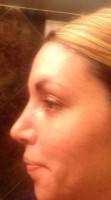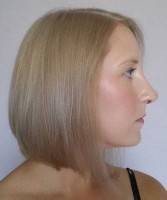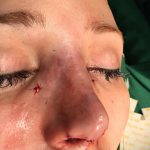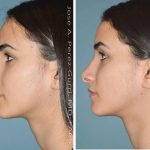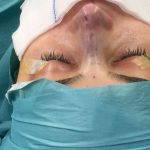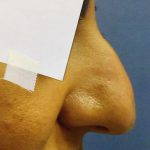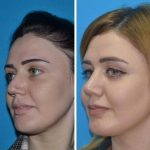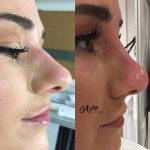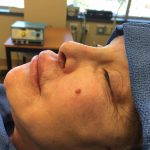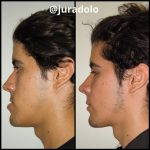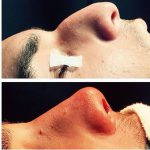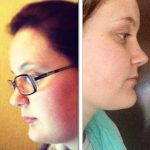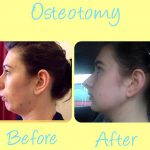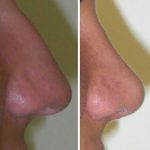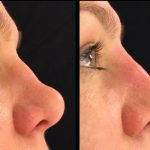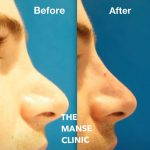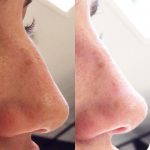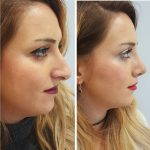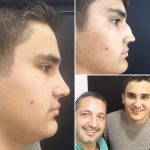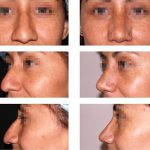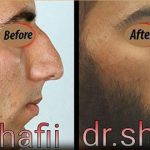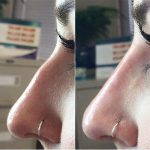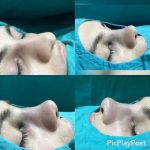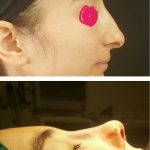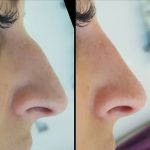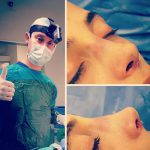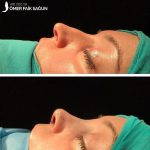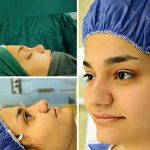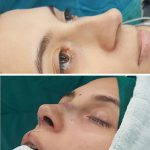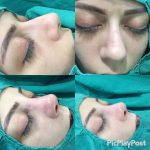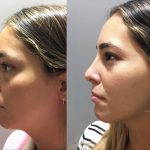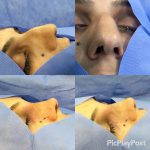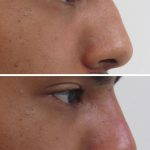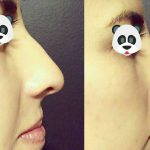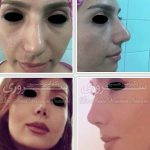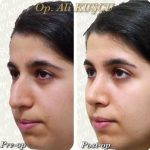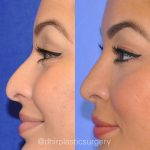Osteotomy Rhinoplasty
Whether or not to make osteotomies (“break nose”) during Rhinoplasty
These are good questions you raise. As far as the anesthesia: a skilled anesthesiologist or crna working with an experienced surgeon can do a fine job using IV sedation, however some anesthesiologists are nervous about “sharing an unprotected airway” with the surgeon, and would prefer to have a closed circuit (breathing tube or intubation).
Your IV sedation doctor should have the ability to intubate you if necessary, and the office must be accredited. A good question to ask is “what would happen if there was some excessive bleeding in my nose during the surgery?”
As far as needing to break your nose – narrow nasal bones in general should not be fractured or overly narrowed, as well as overly short nasal bones, but there are always exceptions. Sometimes after removing a large hump, the bones can appear much wider. Again look at computer simulations, before/after pictures, and pay for a second consultation if necessary until you are comfortable with your choice. (Roy A. David, MD, San Diego Facial Plastic Surgeon)
General and break it!
I typically use general anesthesia for most of my procedures. I think that general anestheis with a tube is a safer option than an unsecure airway with a sedated patient (and fluid dripping into the throat). Be careful of surgeons that want to do a sedation in their office! It is best to be in an accredited facilty. Most rhinoplasty surgeries involve fracturing the bone, esepcaily if there is a hump or any type of narrowing the nose.
It is a rare case that doesn’t need fractures. Patient often get freaked out by the fractures. It is really not a big deal and is associated with little to no pain post-op. That’s hard to believe but true. (Stephen J. Ronan, MD, FACS, San Francisco Plastic Surgeon)
Nose Job options
I can understand your quandary. The anesthesia may not be a problem. Either Conscious Sedation (you awake with IV Sedation) or General Anesthesia (intubated and the anesthesiologist controlling your breathing) work well for this. I personally use General, but this is just my and most of my patient’s preference. The one thing you need to ask is if the surgeon who uses IV Sedation could use General anesthesia if you preferred.
If not, this means that he/she is not operating in a certified facility and/or that he/she does not have privileges for this type of surgery in a hospital or ambulatory surgery center. The question about “breaking” your nose is a little unusual, since virtually all rhinoplasties except those where you are just adding cartilage grafts, require some movement of the nasal bones. Ask about privileges to do anesthesia and for examples of noses similar to you done by each surgeon. If you are still confused, seek another opinion. (Robert T. Buchanan, MD, Highlands Plastic Surgeon)
Overwhelmed by nose job consults
It can be easy to become overwhelmed after several rhinoplasty consults, and resolving differences of opinion is often not possible. Focusing on the technical details, anesthesia type, pattern of fractures, open or closed, can distract you from the bottom line. The important question is how do you wish your nose to look, and which surgeon give you the confidence that he will get you there.
Look over the before and afters on the practice website, and go over computer images of how proposed changes will help you reach the nose that is ‘you’. If you both have a clear destination in mind, it may not matter how you get there. (Peter E. Johnson, MD, Chicago Plastic Surgeon)
Consensus for my nose job?
You will likely never get two consults that are exactly the same. Every surgeon and anesthesiologist will do things a little differently. Choose who you trust and then trust him por her to do what they are commfortable with and what they think is best for you. (Neal Goldberg, MD, Westchester Plastic Surgeon)
Rhinoplasty anesthesia, and bone fracturing (osteotomies)
Don’t worry too much about anesthesia. I have patients under general anesthesia for rhinoplasty, but there are a lot of good surgeons who don’t. The question about osteotomies is a bit bigger and more important. This will definitely have a visible affect on the shape of your upper nose. If you have a hump that is being lowered, you almost certainly will need infracturing of the bones. It is impossible to give you good direction without at least pictures (an exam would be much better). I would suggest either a third opinion, or to use the surgeon with more rhinoplasty experience. (Gordon Lewis, MD, Richmond Plastic Surgeon)
Anesthesia and rhinoplasty
Every surgeon does things a bit differently. Some prefer general others prefer seddation.
As for nasal bone infracturing, that really depends upon the goals of surgery. (Steven Wallach, MD, Manhattan Plastic Surgeon)
If you go to 10 plastic surgeons you will likely hear 10 different ideas on how to approach your nose.
If you are removing a bump then osteotomies are usually necessary. I would make sure to see some before and after photos and see if what you think looks good and what your doctor thinks looks good is on the same page.
This is probably the most important thing, because in the end all you want is good result done in a safe manner.
I personally have 2 different anesthesiologists I work with and one likes to intubate and one likes to use an LMA, which is a tube that stays in your mouth but not down your throat. (David E. Kim, MD, Beverly Hills Plastic Surgeon)
Overwhelmed After my Nose Job Consults
You will have to decide which surgeon does a better job and you can trust. Once, you have made that choice, then you will have to allow him/her to make the decisions about the technical aspects of the surgery.
The best way to choose a surgeon, is to look at as many before and after photos to get a good idea of what to expect. (Mohsen Tavoussi, MD, DO, Huntington Beach Facial Plastic Surgeon)
Overwhelmed After my Nose Job Consults
I believe that for the patient safety general anesthesia with endotracheal intubation allows excellent control of the airway and therefor it is my technique of choice . If you only need tip rhinoplasty then no fracturing of the nasal bones is necessary. Any lowering of the nasal dorsum (hump removal) will require osteotomies(breaking) of the nasal bones and infracturing. (Erel Laufer, MD, Dunedin Plastic Surgeon)
I prefer general anesthetic for nearly all Rhinoplasty Surgeries performed in my practice.
I read your concerns. Since your nose is part of your airway, I prefer general anesthesia with oro-tracheal intubation to protect your airway from post-nasal bleeding encountered during Rhinoplasty Surgery. Many reputable surgeons use IV sedation, but general anesthetic remains my choice for nearly all Rhinoplasty procedures performed in my practice.
Nasal bone osteotomies are required if your nose needs to be narrowed, or if your bridge needs to be lowered. If you’re a borderline case, with respect to the width of your bridge, in my practice, I would typically perform the osteotomies to keep the front view of your bridge as narrow as possible. (Eric M. Joseph, MD, West Orange Facial Plastic Surgeon)
Nosejob basics
Anesthesia is a choice for physicians. Some will perform it under local anesthesia, some under general and others in a twilight. My concerns are with the ones in the middle. Local anesthesia is safe because the patient can protect his lungs from any blood seeping into the back of his throat. General anesthesia protect the lungs by putting a tube in that stops any secretions from dripping. The twilight anesthesia is the most worrisome for aspiration. Breaking the bones depends not on the narrowness of your bones but the size of the bump, small bumps can be filed down, larger bumps require the nose to be broken or the results will not look natural – we call it an open roof deformity – not good! (Robert M. Freund, MD, New York Plastic Surgeon)
Overwhelmed After my Nose Job Consults
Alternatively seek 2 more opinions and discuss your previous opinions with thses new evaluations. (Darryl J. Blinski, MD, Miami Plastic Surgeon)
Differing Opinions After Rhinoplasty Consults
I realize that these diverging opinions are confusing. Unfortunately, there is no way to give a third opinion without pictures, but I can speak to several of the issues.
Intubation: this is a Surgeon preference and one that I share for Rhinoplasty. Do you have not to be intubated? No. However, my preference is to secure the airway with intubation due to the possibility of bleeding and associated concerns about obstruction.
Breaking the Nose (Osteotomies): Osteotomies are necessary in the event of a wide nasal dorsum, or in the event that a moderate to large dorsal hump is removed. In the the circumstances of hump removal, failure to employ osteotomies can lead to a poor aesthetic result.
You will, undoubtedly receive other opinions on these issues. I would advise choosing the Surgeon with a great local reputation, ability to showcase his/her cases, and that speaks to the concerns that you have. (Stephen Prendiville, MD, Fort Myers Facial Plastic Surgeon)
Breaking the nose is a common part of nose surgery but it is not as bad as you think
If there is going to be any work done to reduce a bump of the nose or narrow the nose it is common to break the nose during the surgery.
However, this is very different than the broken nose that results from an accident. Cuts are made to the bone to create precise movement which is well controlled by the doctor.
You should not feel anything if you are completely asleep during the surgery and there is supriasingly minimal pain afterwards as well. (Robert B. Pollack, MD, La Jolla Plastic Surgeon)
In most but not all rhinoplasties, a surgeon does make some very controlled cuts in the nasal bones and narrow them to correspond with the narrowing of the middle third of the nose and the tip.
Medial and lateral osteotomies of the nasal bones are what accomplishes the narrowing of the bridge line after the hump has been removed.
The reason for performing the osteotomies is to prevent a flat top nose or “open roof deformity.” A cast is then applied across the bridge to hold the new nasal bones in the new shape.
For many examples of patients who have had osteotomies, please see the link below to our rhinoplasty photo gallery (William Portuese, MD, Seattle Facial Plastic Surgeon)
Breaking of the Nose
Breaking of the nose also known as “osteotomies” in medical terms is done to either narrow the nasal bridge or reduce a hump.
I like to think of it as a controlled bone cut with very sharp instrument. I’m not sure where that term came from but can only imagine. When rhinoplasty osteotomies was first performed it is possible that the use of unsharp instruments led to ‘breaking of the nose”. Now with use of very sharp instruments, nasal bones can be “cut”. The comparison is: you can use an axe or a chain saw to cut down a tree. Also not all rhinoplasties require “osteotomies” or “breaking of the nose”. (Oleh Slupchynskyj, MD, FACS, New York Facial Plastic Surgeon)
Will my nose be broken during a rhinoplasty?
Not necessarily. Most rhinoplasties do require breaking the nose. The ones that don’t are ones in which the tip is the only unattractive part of the nose and it can be done alone. Most rhinoplasties in which a hump is removed will require breaking of the bones. (Jack P. Gunter, MD, Dallas Plastic Surgeon)
If you are committed to a plastic surgeon, you need to be confident that they will do the right thing. I do the surgery with the patient either sedated or completely asleep and the nose is numbed with local anesthesia.
If I must break the nose to give you the proper result , then I will. It does not hurt and you don’t even know that it was broken after the surgery. You must have confidence in your surgeon and understand the procedure. There is nothing to be afraid of. (William B. Rosenblatt, MD, New York Plastic Surgeon)
Osteotomies (term used for breaking and repositioning of nasal bones in rhinoplasty osteotomies) is actually one of the more simple maneuvers in rhinoplasty and does not necessarily correlate to an increase in pain although it does cause more bruising.
The nose will not need to be broken if you are having rhinoplasty to:
- Make subtle changes to the tip
- Make subtle changes to the bridge
- Reshape a wide and flat nose (African, Southeast Asian, or Latin American noses)
The nose will likely need to be broken if you are having rhinoplasty to:
- Make dramatic changes to the bridge (for example remove a large hump)
- Narrow the nose significantly
- Correct a broken nose or an asymmetric nose (Sam Naficy, MD, Seattle Facial Plastic Surgeon)
Osteotomy Rhinoplasty Before After
- Rhinoplasty With Osteotomy Result
- Osteotomy Rhinoplasty Treatment
- Osteotomy Rhinoplasty Recovery Photos
- Osteotomy Rhinoplasty Is An Operation In Which A Bone Is Divided Or A Piece Of Bone Is Excised
- Osteotomy Rhinoplasty Hump Removal
- Osteotomy Rhinoplasty Healing Time
- Osteotomy Rhinoplasty For Wide Nasal Base
- Osteotomy Rhinoplasty For Man
- Osteotomy Rhinoplasty Before After (8)
- Osteotomy Nose
- Osteotomy Of The Nose
- Osteotomy Rhinoplasty Before After (1)
- Osteotomy Rhinoplasty Before After (2)
- Osteotomy Rhinoplasty Before After (3)
- Osteotomy Rhinoplasty Before After (4)
- Osteotomy Rhinoplasty Before After (5)
- Osteotomy Rhinoplasty Before After (6)
- Osteotomy Rhinoplasty Before After (7)
- Osteotomy Nose Procedure Pic
- Osteotomy Nose Job
- Osteotomy Nose Before And After (4)
- Osteotomy Nose Before And After (3)
- Osteotomy Nose Before And After (2)
- Osteotomy Nose Before And After (1)
- Osteotomy In Rhinoplasty Photo
- Osteotomies Revision Rhinoplasty
- Not All Rhinoplasties Require The Use Of A Form Of Osteotomy
- Bilateral Osteotomy Nose
- External Osteotomy In Rhinoplasty
- Female Osteotomy Rhinoplasty Treatment
- Indications For Osteotomies In Rhinoplasty Are Anatomic Findings Of A High Nasal Dorsum
- Lateral Osteotomy Deviated Nose
- Medial Osteotomy Nose Photos
- Medial Osteotomy Performed During Rhinoplasty
- Nasal Bone Osteotomy
- Nasal Osteotomy

